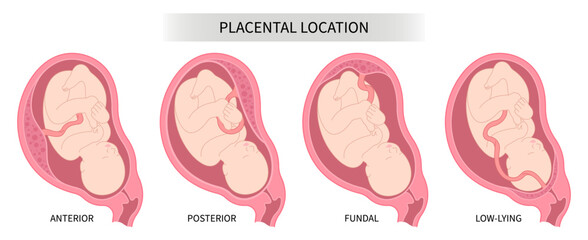The placenta is a remarkable organ that forms in your womb to sustain your infant and your pregnancy. It filters out carbon dioxide and waste from the baby’s bloodstream, acts as its lungs and liver, provides its nourishment, and even passes antibodies to the baby just before birth to bolster its immune system.
For the mother, it makes the hormones that sustain her pregnancy, enables her to produce milk, and even primes her to nurture her baby [*].
It is the only organ in the body that serves two masters independently, and the only organ that is disposable after the baby is born. The placenta also serves as a “black box” of your pregnancy, revealing the cause and timing of a number of adverse effects in pregnancy.
Where the placenta implants in the womb can definitely affect the experience of your pregnancy, but placentas can and do attach in myriad ways. Here, we take a closer look at the anterior placenta position — what it means for you and your baby.
What Is Anterior Placenta?
An anterior placenta means the placenta is attached to the front wall of the uterus, up against the mother’s abdomen. There’s no cause for concern, but there are four main things to be aware of with an anterior placenta:
-
It may take longer to feel the baby’s first kicks because of the padding of the placenta between you and the baby.
-
Procedures like amniocentesis can be more difficult to perform.
-
It can be more difficult for your physician to find the baby’s heartbeat with hand-held Doppler ultrasound as they scan across your belly with the placenta in the way.
-
In the event you have a c-section, the incision will need to be made in a location that avoids cutting into the placenta.

Anterior, posterior, fundal, and low-lying are common placenta locations. The placenta can implant laterally as well although it’s not as common. And while the images here make placenta locations seem pretty clear cut, there are two axes to consider: An anterior placenta can also be fundal or low-lying. The same is true of posterior and lateral locations.
How Common Is Anterior Placenta?
Anterior placenta is very common, seen in around half of all pregnancies, followed by posterior, lateral, and fundal placentations. Researchers don’t know exactly why the placenta implants where it does, but there are some studies to suggest that blood type, blood pressure, and sleeping position affect placentation.
Anterior placentation is more common among women with type O blood (posterior placenta had an association with A-positive blood types) [*]. A 2014 study found that maternal blood pressure and sleeping position in early pregnancy may also affect where the placenta implants in the womb. In one study, women who slept supine (on their backs) were more likely to have anterior placentation [*]. In another, earlier study, women who slept on their backs were more likely to have high or fundal placentation [*].
Benefits of Anterior Placenta
There are no known benefits to having an anterior placenta, other than the fact that your doctor or midwife is likely to have seen it many times before, and you may feel less pain from the baby kicking.
That said, there isn’t a lot of research into maternal or fetal outcomes based on where the placenta implants. Most of the research regarding placentation focuses on identifying the frequency of placental disorders across the range of placenta positions.
Anterior Placenta Risks
Anterior placentation increases the likelihood that your baby could be in the occiput posterior (OP) position, with its head down, its face up, and its back against your back. This could contribute to more back pain and a longer or more painful labor. Your care provider may try to manually rotate the fetus to mitigate the complications associated with the OP position [*].
While not regarded as a cause for concern, one study found anterior placentation to be associated with a later onset of labor, a higher rate of induction and c-section, and postpartum complications such as manual removal of the placenta and postpartum hemorrhaging [*].
A 2013 study from the Turkish-German Gynecological Association found anterior placentation to be associated with an increased risk of pregnancy-induced hypertension, gestational diabetes mellitus, placental abruption, intrauterine growth retardation, and intrauterine fetal death.
Because it is harder to feel the baby’s movements with an anterior placenta, mothers may feel some anxiety in trying to feel and monitor their baby’s movements in the early stages of pregnancy. But when junior gets a little bigger and stronger, you may be glad to have a little extra padding.
Again, an anterior placenta is normal, common, and does not affect the placenta’s ability to sustain the fetus. It may change the experience of your pregnancy and your labor, but vaginal delivery should be possible in all but low-lying positions.
Anterior Placenta Diagnosis
Placenta location is usually diagnosed with the ultrasound scan at 18-20 weeks.
The placenta is fully formed at about 12 weeks of pregnancy and can be seen on an ultrasound scan as early as 10 weeks’ gestation [*]. It weighs about a pound at delivery, measures about 10’ long by 1” thick, and is dense with blood vessels called villi.
Once the placenta implants, it cannot be moved, but it does tend to migrate up and away from the cervix, toward better blood supply, as pregnancy progresses and the womb expands, right up until 32 weeks’ gestation. When the placenta migrates, it doesn’t come away from the uterine wall and reattach itself, but rather, grows upward as its lower regions diminish and recede.
Placentas that are low-lying are a concern, as they can block the baby’s exit from the uterus (known as placenta previa) and lead to severe hemorrhaging if vaginal delivery is attempted. The good news is, a low-lying anterior placenta is more likely to migrate than a low-lying posterior placenta [*].
Most placentas move to the top or side of the uterus by the 32-week mark to allow a clear path to delivery through the cervix.
What Does Baby Movement Feel Like With Anterior Placenta?
The sensation of the baby's kicks and punches may be muted by the placenta and felt later in your pregnancy. You may feel a fluttering or rolling sensation with baby’s movements or feel baby’s kicks down the sides of your belly or low in the abdomen.
At the beginning of the third trimester, when the fetus is bigger and has a more predictable pattern of movements, you may have a stronger sensation. Your care provider may have you record kick counts or other movements to monitor baby’s progress in the womb.
When to Call Your Doctor
If you are experiencing cramping, vaginal bleeding, have stopped feeling the fetus move, or by 24 weeks have not felt the baby move, contact your care team.
Anterior Placenta FAQ
Are anterior placentas more common with girls?
There’s no definitive study linking fetal gender and location of the placenta, but there is one interesting Iranian study from 2014 in which 200 women with anterior and posterior placentas (103 anterior, 93 posterior) at 11-13 weeks gestation were studied to see if there was a link between fetal gender and placenta location. In the anterior group, 72.8% had baby girls [*].
When should I be worried about fetal movement with anterior placenta?
If you don’t feel any movements at 24 weeks, contact your care team.
Are you bigger with an anterior placenta?
No, your baby bump will look the same as with any other placenta location.
Is anterior placenta more uncomfortable?
You may experience some discomfort in the abdominal area from the expansion of the uterus and the pressure on the abdominal muscles, but it should go away as your pregnancy progresses [*]. If the baby’s spine is up against your spine, you may feel some back pain during your pregnancy.
Is labor harder with an anterior placenta?
Not necessarily, although the anterior placenta can make it harder for the baby to descend into the birth canal. If the baby is in the OP position, with their spine against your spine, you may feel the effects of back labor. But each pregnancy is unique and there’s no reason to be anxious about your labor with an anterior placenta.
Does anterior placenta mean C-section?
No, a vaginal delivery should be possible with an anterior placenta. The bigger concern is a low-lying placenta or placenta previa, a condition in which the placenta implants in a way that covers the cervix. When the placenta is covering all or part of the cervix, your care team will perform a C-section to get the baby out and prevent hemorrhaging. They will use ultrasound to guide the incision to ensure they’re not cutting into the placenta.
Does anterior placenta cause breech baby?
No, there is no evidence linking anterior placentation to breech position. Some studies have suggested a link between cornual-fundal placentation and breech presentation at birth [*].
Is anterior placenta less painful?
With the placenta shielding you from baby’s kicks and punches, you may feel less pain than in other placenta positions, but every pregnancy is unique.
Can You Save Cord Blood With an Anterior Placenta?
Yes, you can save cord blood with the placenta in anterior – and any other – location, whether you deliver vaginally or have a c-section.
MiracleCord offers the industry’s most affordable, full-service cord blood and cord tissue banking services. We use the latest technologies to maximize viability and stem cell recovery from your baby's cord blood and tissue, and make it easy for your care team to collect the specimens safely and effectively.
With more than 80 FDA-approved cord blood stem cell treatments and hundreds of clinical trials initiated, cord blood is a great way to be prepared in the event your baby or other family members are facing a life-threatening disease or condition.
For more information on cord blood applications, download our free info kit or call 888.743.2673 to speak to one of our knowledgeable customer service representatives.
The Bottom Line
An anterior placenta is very common and is considered normal. The placenta will still be able to sustain your pregnancy and you should be able to deliver vaginally unless the placenta is also low-lying.
While an anterior placenta is associated with certain risks, there’s no cause for alarm if you’ve been diagnosed with an anterior placenta. If you have concerns, talk to your care team about what to expect with an anterior placenta, and monitor your pregnancy pursuant to your care provider's guidelines.
DISCLAIMER: THE INFORMATION ON THIS WEBSITE IS NOT INTENDED TO BE USED AS MEDICAL ADVICE.The materials and information contained on the MiracleCord website is provided for educational and informational purposes only, and is not intended to, and does not constitute, medical or other health advice or diagnosis, and should not be used as such. You should not use this information to diagnose or treat a health problem or disease. If you are seeking personal medical advice, you should consult with a licensed physician. Always consult with a qualified health care provider regarding a medical condition.




